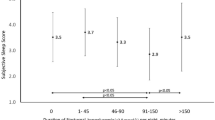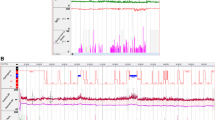Abstract
Non-dipping, ie failure to lower blood pressure during sleep, has been found to be more prevalent in diabetic than in non-diabetic subjects. However, the reasons remain to be clarified. Diabetic patients may wake up more frequently during the night (for instance, due to nocturia). This may result in inclusion of awake blood pressure measurements in the night-time average and thus erroneously raise this average, causing misclassification of patients as non-dippers. However, non-dipping in diabetes may be due to blunted effect of sleep itself on blood pressure secondary to autonomic neuropathy. We undertook this study in order to further clarify this question. We studied 23 diabetic patients, and 23 matched controls who underwent 24-h ambulatory blood pressure monitoring, and reported taking an afternoon nap. Afternoon nap, by virtue of its short duration, is devoid of interruptions, and thus can be used as a model for tiled, non-interrupted sleep. We found that, both in diabetic patients and controls, blood pressure declined during the afternoon nap in a similar magnitude to the night-time decline. However, this decline was significantly blunted in the diabetic patients (13.9 ± 2.2% decline in diastolic blood pressure during naptime in the diabetic patients, as compared with 24 ± 2.3% decline in diastolic blood pressure during the siesta in the control group, P < 0.02). The blunted decline of blood pressure during the nap in diabetic patients demonstrates that non-dipping is due to the blunted effect of sleep itself. This can be another facet of autonomic dysfunction seen in diabetes mellitus.
This is a preview of subscription content, access via your institution
Access options
Subscribe to this journal
Receive 12 digital issues and online access to articles
$119.00 per year
only $9.92 per issue
Buy this article
- Purchase on Springer Link
- Instant access to full article PDF
Prices may be subject to local taxes which are calculated during checkout

Similar content being viewed by others
References
White WB, Schulman P, McCabe EJ, Dey HM . Average daily blood pressure, not office blood pressure, determines cardiac function inpatients with hypertension JAMA 1989; 261: 873–877
Mancia G et al. Ambulatory blood pressure is superior to clinic blood pressure in predicting treatment related regression of left ventricular hypertrophy Circulation 1997; 95: 1464–1470
Verdecchia P et al. Circadian blood pressure changes and left ventricular hypertrophy in essential hypertension Circulation 1990; 81: 528–536
Kuwajima I et al. Diminished nocturnal decline in blood pressure in elderly hypertensivepatients with left ventricular hypertrophy Am Heart J 1992; 123: 1307–1311
Bianchi S et al. Diurnal variations of blood pressure and microalbuminuria in essential hypertension Am J Hypertens 1994; 7: 23–29
Shimada K et al. Diurnal blood pressure variations and silent cerebrovascular damage in elderlypatients with hypertension J Hypertens 1992; 10: 875–878
Pickering TG . The clinical significance of diurnal blood pressure variations, dippers and nondippers Circulation 1990; 81: 700–702
Pickering TG, James GD . Determinants and consequences of the diurnal rhythm of blood pressure Am J Hypertens 1993; 6: 166S–169S
Verdecchia P et al. Blunted nocturnal fall in blood pressure in hypertensive women with future cardiovascular morbid events Circulation 1993; 88: 986–992
Verdecchia P et al. Ambulatory blood pressure – an independent predictor of prognosis in essential hypertension Hypertension 1994; 24: 793–801
Mann S, Altman DJ, Raftery EB, Bannister R . Circadian variation of blood pressure in autonomic failure Circulation 1983; 68: 477–483
Holl RW, Pavlovic M, Heinze E, Thon A . Circadian blood pressure during the early course of type 1 diabetes. Analysis of 1011 ambulatory blood pressure recordings in 354 adolescents and young adults Diabetes Care 1999; 22: 1151–1157
Fogari R et al. Urinary albumin excretion and nocturnal blood pressure in hypertensivepatients with type II diabetes mellitus Am J Hypertens 1994; 7: 808–813
Berrut G et al. Value of ambulatory blood pressure monitoring in type I (insulin-dependent) diabeticpatients with incipient diabetic nephropathy Am J Hypertens 1994; 7: 222–227
Spallone V et al. Relationship between autonomic neuropathy, 24-h blood pressure profile, and nephropathy in normotensive IDDMpatients Diabetes Care 1994; 17: 578–584
Hornung RS, Mahler RF, Raftery EB . Ambulatory blood pressure and heart rate in diabeticpatients: an assessment of autonomic function Diabetic Med 1989; 6: 579–585
Hansen KW, Poulsen PL, Mogensen CE . Ambulatory blood pressure and abnormal albuminuria in type 1 diabeticpatients Kidney Int Suppl 1994; 45: S134–S140
Lurbe A et al. Altered blood pressure during sleep in normotensive subjects with type 1 diabetes Hypertension 1993; 21: 227–235
Hansen KW . Diurnal blood pressure profile, autonomic neuropathy and nephropathy in diabetes Eur J Endocrinol 1997; 136: 35–36
Molgaard H et al. Association of 24-h cardiac parasympathetic activity and degree of nephropathy in IDDMpatients Diabetes 1992; 41: 812–817
Grossman E et al. Left ventricular mass in diabetes-hypertension Arch Intern Med 1992; 152: 1001–1004
Hansen KW, Poulsen PL, Christiansen JS, Mogensen CE . Determinants of 24-h blood pressure in IDDMpatients Diabetes Care 1995; 18: 529–535
Hansen KW, Pedersen MM, Christiansen JS, Mogensen CE . Diurnal blood pressure variation in normoalbuminuric type 1 diabeticpatients J Intern Med 1993; 234: 175–180
Perk G, Ben-Arie L, Mekler J, Bursztyn M . Dipping status may be determined by nocturnal urination Hypertension 2001; 37: 749–752
Bursztyn M, Mekler J, Ben Ishay D . The siesta and ambulatory blood pressure: is waking up the same in the morning and the afternoon? J Hum Hypertens 1996; 10: 287–292
Bursztyn M, Mekler J, Wachtel N, Ben Ishay D . Siesta and ambulatory blood pressure monitoring. Comparability of the afternoon nap and night sleep Am J Hypertens 1994; 7: 217–221
White WB, Johanseen PL, McCabe EJ, Omvik P . Clinical evaluation of the Accutracker II ambulatory blood pressure monitor: assessment of performance in two countries and comparison with sphygmomanometry and intra-arterial blood pressure at rest and during exercise J Hypertens 1989; 7: 967–975
Baumgart P et al. Twenty-four hour blood pressure is not dependent on endogenous circadian rhythm J Hypertens 1989; 7: 331–334
Chau NP et al. Twenty-four-hour ambulatory blood pressure in shift workers Circulation 1989; 80: 341–347
Author information
Authors and Affiliations
Corresponding author
Rights and permissions
About this article
Cite this article
Perk, G., Mekler, J., Ben Ishay, D. et al. Non-dipping in diabetic patients: insights from the siesta. J Hum Hypertens 16, 435–438 (2002). https://doi.org/10.1038/sj.jhh.1001412
Received:
Revised:
Accepted:
Published:
Issue Date:
DOI: https://doi.org/10.1038/sj.jhh.1001412
Keywords
This article is cited by
-
High prevalence of non-dipping patterns among Black Africans with uncontrolled hypertension: a secondary analysis of the CREOLE trial
BMC Cardiovascular Disorders (2021)
-
Microbiota-governed microRNA-204 impairs endothelial function and blood pressure decline during inactivity in db/db mice
Scientific Reports (2020)
-
Blood pressure variability over 24 h: prognostic implications and treatment perspectives. An assessment using the smoothness index with telmisartan–amlodipine monotherapy and combination
Hypertension Research (2014)
-
Afternoon Blood Pressure Increase: A Blood Pressure Pattern Associated With Microvascular Complications in Type 2 Diabetes Mellitus
American Journal of Hypertension (2011)
-
Non-dipping pattern in ambulatory blood pressure monitoring is associated with metabolic abnormalities in a random sample of middle-aged subjects
Hypertension Research (2009)



